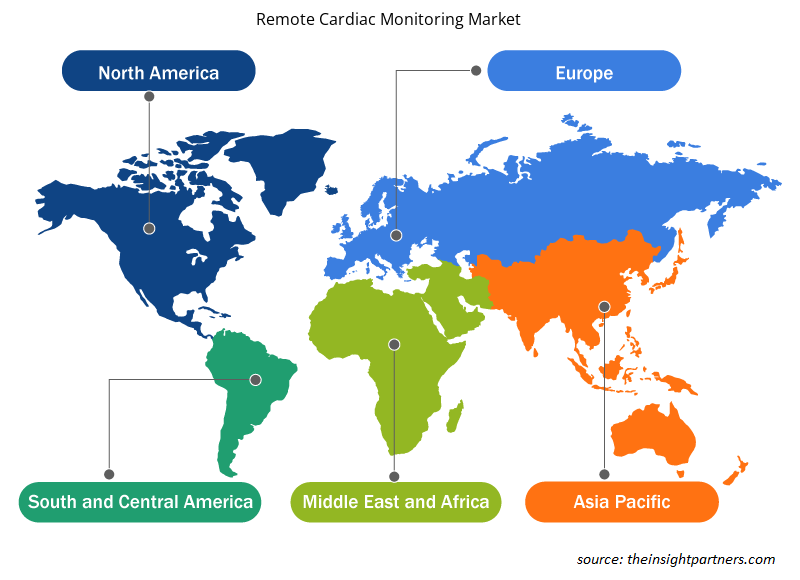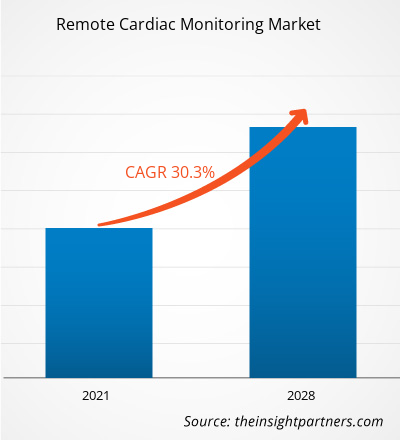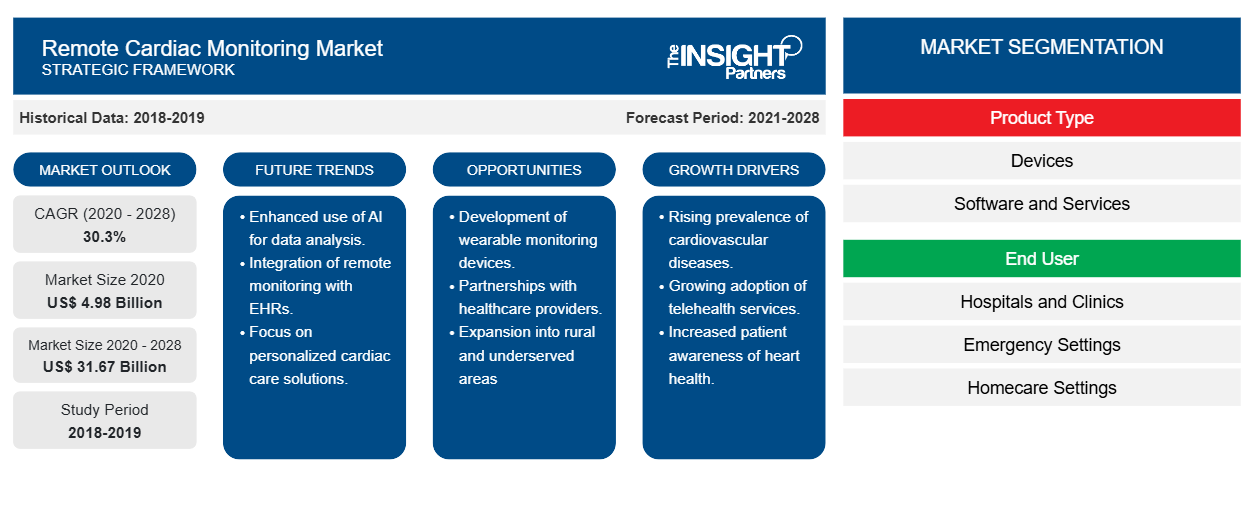Le marché de la surveillance cardiaque à distance devrait atteindre 31 671,69 millions USD d'ici 2028, contre 4 976,40 millions USD en 2021 ; il devrait croître à un TCAC de 30,3 % de 2021 à 2028.CAGR of 30.3% from 2021 to 2028.
Les dispositifs de surveillance cardiaque à distance permettent une surveillance continue des activités électriques du cœur en dehors des hôpitaux. Ils permettent également la surveillance électrocardiographique (ECG) à domicile des patients suspectés d'arythmies cardiaques ou présentant un risque de développer des arythmies. La surveillance peut également être effectuée lorsque les patients sont absorbés par leurs activités quotidiennes. Ainsi, l'un des avantages les plus importants de la surveillance cardiaque à distance est qu'elle réduit le besoin de visites de routine chez le médecin. Des dispositifs tels que des stimulateurs cardiaques et des défibrillateurs cardioverteurs implantables sont implantés dans le cœur des patients grâce à des procédures mini-invasives. Un émetteur qui fonctionne en synchronisation avec l'appareil assure la transmission des données. Des facteurs tels que l'augmentation de l'incidence des maladies cardiovasculaires (MCV) et les développements continus de l'approche de la télémédecine stimulent la croissance du marché de la surveillance cardiaque à distance . Cependant, les préoccupations concernant la confidentialité des données entravent la croissance du marché.
Personnalisez ce rapport en fonction de vos besoins
Vous bénéficierez d'une personnalisation gratuite de n'importe quel rapport, y compris de certaines parties de ce rapport, d'une analyse au niveau des pays, d'un pack de données Excel, ainsi que de superbes offres et réductions pour les start-ups et les universités.
- Obtenez les principales tendances clés du marché de ce rapport.Cet échantillon GRATUIT comprendra une analyse de données, allant des tendances du marché aux estimations et prévisions.
Informations sur le marché
Augmentation de l'incidence des maladies cardiovasculaires
La surveillance à distance des patients (RPM) permet aux patients de mieux gérer leur santé en augmentant leur implication dans leurs soins de santé. L'American Heart Association soutient les initiatives visant à encourager la conception et l'utilisation de technologies de surveillance à distance des patients fondées sur des données probantes. Selon l'Organisation mondiale de la santé (OMS), les maladies cardiovasculaires (MCV) sont parmi les principales causes de décès dans le monde et environ 30 millions de personnes subissent un accident vasculaire cérébral chaque année. Selon l'American Heart Association, près de la moitié des adultes aux États-Unis souffrent d'un type de MCV. En outre, plus de 130 millions de personnes, soit 45,1 % de la population américaine, devraient souffrir d'un type de MCV d'ici 2035. Selon les rapports de la Société européenne de cardiologie, les MCV causent 3,9 millions de décès en Europe et plus de 1,8 million de décès dans l'Union européenne (UE). De plus, elles représentent 45 % de tous les décès en Europe et 37 % du total des décès dans l'UE. Dans les pays de la région Asie-Pacifique, la mortalité due aux maladies cardiovasculaires varie de moins de 20 % dans des pays comme la Thaïlande, les Philippines et l’Indonésie à 20 à 30 % dans les zones urbaines de Chine, de Hong Kong, du Japon, de Corée et de Malaisie. En outre, la Nouvelle-Zélande, l’Australie et Singapour, entre autres, affichent des taux relativement élevés de 30 à 35 %.
L'hypertension est un facteur de risque important pour les maladies cardiovasculaires. La prévalence de l'hypertension ajustée selon l'âge chez les adultes aux États-Unis est d'environ 35 %, ce qui équivaut à une population d'environ 85 millions de personnes. D'ici 2035, environ 42 % des adultes du pays, soit 27 millions de plus, souffriront de cette maladie. Le fardeau financier de l'hypertension sur les économies est également en hausse, et les coûts devraient grimper d'environ 70 milliards de dollars américains en 2015 à environ 150 milliards de dollars américains d'ici 2035. La surveillance à distance des patients peut servir de moyen essentiel pour améliorer le contrôle de l'hypertension et réduire le fardeau économique découlant des séjours hospitaliers prolongés ou fréquents résultant d'événements liés à l'hypertension aiguë. Des recherches ont montré que la surveillance à distance des patients (RPM) peut réduire considérablement la pression artérielle systolique (PAS) et la pression artérielle diastolique (PAD) par rapport aux soins habituels et à l'autosurveillance seule. Selon quelques essais non randomisés, les dispositifs RPM peuvent améliorer les résultats en permettant une détection précise et précoce ainsi qu'en réduisant les taux de mortalité toutes causes confondues et les hospitalisations. Les directives cliniques récentes recommandent fortement l'utilisation du RPM pour la détection de la fibrillation auriculaire (FA) chez les patients victimes d'AVC et les patients non victimes d'AVC.
Informations basées sur le type de produit
En fonction du type de produit, le marché de la surveillance cardiaque à distance est encore segmenté en appareils, logiciels et services. Le segment des appareils détenait une part de marché plus importante en 2021 et devrait enregistrer un TCAC plus élevé au cours de la période de prévision.
Informations basées sur l'utilisateur final
En fonction de l'utilisateur final, le marché de la surveillance cardiaque à distance est segmenté en hôpitaux et cliniques, services d'urgence, services de soins à domicile et autres. Le segment des hôpitaux et cliniques détiendrait la plus grande part de marché en 2021, tandis que le marché du segment des services d'urgence devrait croître à un TCAC de 31,60 % au cours de la période de prévision.
Diverses entreprises opérant sur le marché de la surveillance cardiaque à distance adoptent des stratégies telles que les lancements de produits, les fusions et acquisitions, les collaborations, les innovations de produits et les extensions de portefeuille de produits pour étendre leur empreinte dans le monde entier, maintenir la marque et répondre à la demande croissante des utilisateurs finaux.
Aperçu régional du marché de la surveillance cardiaque à distance
Les tendances et facteurs régionaux influençant le marché de la surveillance cardiaque à distance tout au long de la période de prévision ont été expliqués en détail par les analystes d’Insight Partners. Cette section traite également des segments et de la géographie du marché de la surveillance cardiaque à distance en Amérique du Nord, en Europe, en Asie-Pacifique, au Moyen-Orient et en Afrique, ainsi qu’en Amérique du Sud et en Amérique centrale.

- Obtenez les données régionales spécifiques au marché de la surveillance cardiaque à distance
Portée du rapport sur le marché de la surveillance cardiaque à distance
| Attribut de rapport | Détails |
|---|---|
| Taille du marché en 2020 | 4,98 milliards de dollars américains |
| Taille du marché d'ici 2028 | 31,67 milliards de dollars américains |
| Taux de croissance annuel composé mondial (2020-2028) | 30,3% |
| Données historiques | 2018-2019 |
| Période de prévision | 2021-2028 |
| Segments couverts | Par type de produit
|
| Régions et pays couverts | Amérique du Nord
|
| Leaders du marché et profils d'entreprises clés |
|
Densité des acteurs du marché : comprendre son impact sur la dynamique des entreprises
Le marché de la surveillance cardiaque à distance connaît une croissance rapide, tirée par la demande croissante des utilisateurs finaux en raison de facteurs tels que l'évolution des préférences des consommateurs, les avancées technologiques et une plus grande sensibilisation aux avantages du produit. À mesure que la demande augmente, les entreprises élargissent leurs offres, innovent pour répondre aux besoins des consommateurs et capitalisent sur les tendances émergentes, ce qui alimente davantage la croissance du marché.
La densité des acteurs du marché fait référence à la répartition des entreprises ou des sociétés opérant sur un marché ou un secteur particulier. Elle indique le nombre de concurrents (acteurs du marché) présents sur un marché donné par rapport à sa taille ou à sa valeur marchande totale.
Les principales entreprises opérant sur le marché de la surveillance cardiaque à distance sont :
- Systèmes OSI, Inc.
- GE Santé
- Biotronik Se
- Société Nihon Kohden
- Laboratoires Abbott
Avis de non-responsabilité : les sociétés répertoriées ci-dessus ne sont pas classées dans un ordre particulier.

- Obtenez un aperçu des principaux acteurs du marché de la surveillance cardiaque à distance
Marché de la surveillance cardiaque à distance – par type de produit
- Appareils
- Logiciel
- Services
Marché de la surveillance cardiaque à distance – par utilisateur final
- Hôpitaux et cliniques
- Paramètres d'urgence
- Cadres de soins à domicile
- Autres
Marché de la surveillance cardiaque à distance – par géographie
- Amérique du Nord
- NOUS
- Canada
- Mexique
- Europe
- France
- Allemagne
- Italie
- ROYAUME-UNI
- Espagne
- Reste de l'Europe
- Asie-Pacifique (APAC)
- Chine
- Inde
- Corée du Sud
- Japon
- Australie
- Reste de l'Asie-Pacifique
- Moyen-Orient et Afrique (MEA)
- Afrique du Sud
- Arabie Saoudite
- Émirats arabes unis
- Reste du Moyen-Orient et de l'Afrique
- Amérique du Sud et Amérique centrale (SCAM)
- Brésil
- Argentine
- Reste de l'Amérique du Sud et de l'Amérique centrale
Profils d'entreprise
- Systèmes OSI, Inc.
- GE Santé
- Biotronik Se
- Société Nihon Kohden
- Laboratoires Abbott
- Société scientifique de Boston
- Royal Philips NV
- Honeywell International, Inc.
- AMC Santé
- Analyse historique (2 ans), année de base, prévision (7 ans) avec TCAC
- Analyse PEST et SWOT
- Taille du marché Valeur / Volume - Mondial, Régional, Pays
- Industrie et paysage concurrentiel
- Ensemble de données Excel
Rapports récents
Témoignages
Raison d'acheter
- Prise de décision éclairée
- Compréhension de la dynamique du marché
- Analyse concurrentielle
- Connaissances clients
- Prévisions de marché
- Atténuation des risques
- Planification stratégique
- Justification des investissements
- Identification des marchés émergents
- Amélioration des stratégies marketing
- Amélioration de l'efficacité opérationnelle
- Alignement sur les tendances réglementaires





















 Obtenez un échantillon gratuit pour - Marché de la surveillance cardiaque à distance
Obtenez un échantillon gratuit pour - Marché de la surveillance cardiaque à distance